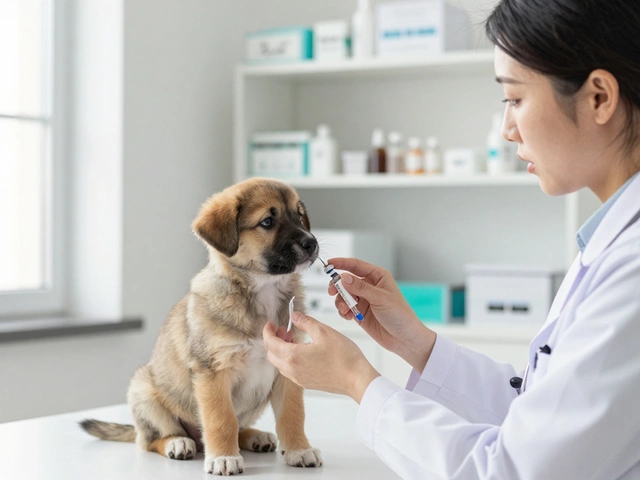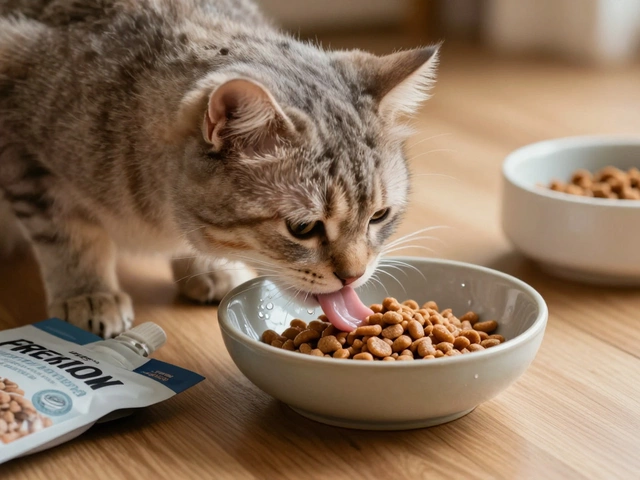
Picking the right dog food turns into a headache the minute you check the shelves. Fancy labels, endless flavors, and some bags cost as much as your monthly phone bill. So who do you trust? Most folks turn to veterinarians because, well, they deal with dogs every single day. Vets know what works and what ends up causing trouble in the long run.
It really isn’t about picking the expensive or trendiest brand. Vets base their advice on stuff like nutrition research, what actually keeps dogs healthy, and the issues they see in their clinics—from upset stomachs to allergies. They look for foods that do more than fill your dog’s bowl; they want something that supports your pet’s health every day.
If you’re just starting to figure all this out, you’ll find it simpler to focus on vet-recommended options. These usually avoid sketchy fillers, keep ingredients balanced, and are backed by large, long-term studies—unlike some random internet fads.
- Why Listen to Vets About Dog Food?
- What Makes a Dog Food Vet-Recommended?
- Popular Vet-Recommended Dog Foods
- Tips for Picking the Right Food for Your Dog
Why Listen to Vets About Dog Food?
Ever notice that the stuff your vet talks about seems to stick around longer than the latest social media trend? That’s because veterinarian recommended advice comes from years of real-life experience—not from ad campaigns or the word on the street. Vets spend years studying animal nutrition, biology, and disease. This isn’t guesswork. They see what happens when dogs eat right and when they don’t. Plus, they hear about problems connected to food way before the general public does.
Companies can make flashy claims on dog food bags, but vets look past these and focus on hard facts. They keep up with research published in journals like The Journal of Veterinary Internal Medicine and often attend extra nutrition courses. Most have seen what happens when a food cuts corners—for example, in 2018, vets were first to notice a link between certain grain-free foods and heart problems in dogs.
Here’s how a dog food ends up on a vet’s shortlist:
- The brand funds nutrition research and runs feeding trials that prove their food actually works.
- They have real nutritionists and vets on staff, not just marketing teams.
- Foods are tested for quality and safety way more often than the law requires.
- They follow guidelines set by the Association of American Feed Control Officials (AAFCO) or equivalent groups.
Why trust your vet’s advice? Because they see patterns across hundreds, sometimes thousands of dogs. They know which foods upset sensitive stomachs. They notice when dogs get shiny coats or when weird allergies clear up. Their advice isn’t coming from one picky dog or social media videos—it’s coming from hands-on experience and hard numbers.
| Reason vets are trusted | How it helps your dog |
|---|---|
| Stay up on new health risks | Your pup avoids the latest food-related scares |
| See real results in practice | You get recommendations that work for many dogs |
| Understand nutrition basics | Your dog gets the right nutrients and balanced meals |
So when your vet says a certain food is best, they're not just repeating a sales pitch. They’re staking their reputation on what really keeps dogs healthy—and that’s pretty reassuring.
What Makes a Dog Food Vet-Recommended?
If you’ve ever seen a food bag stamped with “veterinarian recommended,” you might wonder what makes it stand out from the rest. Vets don’t just pick these products because of flashy marketing—they look for a few non-negotiable things.
For starters, ingredient quality matters. Vets check that the food lists real meat or fish as the main protein source, not a bunch of vague “meat by-products.” They also watch out for extra junk like artificial colors and unneeded fillers. You’ll usually find fewer weird-sounding ingredients in vet recommended dog food.
Nutrition balance is a big piece of the puzzle. Good brands run actual feeding trials to prove that their recipes are safe and provide complete nutrition. According to guidelines from the Association of American Feed Control Officials (AAFCO), balanced dog foods must hit certain protein, fat, and nutrient targets. Companies like Hill’s Science Diet, Royal Canin, and Purina Pro Plan do these tests—they don’t just say it on the bag.
Vets also trust brands that have a team of credentialed nutritionists and veterinarians formulating and checking recipes. Some small boutique brands skip this, and that’s a red flag to most animal docs.
- Clear labeling and transparency about ingredients and sourcing.
- Safety standards like batch testing and recalls handled quickly.
- Proof of scientific research supporting claims—not just marketing buzzwords.
Want some hard data? The World Small Animal Veterinary Association points out that most major vet-recommended brands follow tough safety and quality practices. Here’s how a few common picks stack up:
| Brand | Amino Acid Balance | Feeding Trials Done? | Nutritionists On Staff? |
|---|---|---|---|
| Hill’s Science Diet | Yes | Yes | Yes |
| Purina Pro Plan | Yes | Yes | Yes |
| Royal Canin | Yes | Yes | Yes |
The point is, the best dog food isn’t just popular—it’s backed by real science and regular safety checks. That’s what earns a place on your vet’s list of recommendations.

Popular Vet-Recommended Dog Foods
If you ask five different vets what they feed their own dogs, you’ll probably hear the same brands pop up again and again. Veterinarian recommended dog food isn’t about hype—it’s about formulas that don’t cut corners, stay consistent, and actually show results in real dogs.
The biggest names you’ll hear from most vets are:
- Hill’s Science Diet: Created by actual veterinarians and nutritionists, this brand put years into research before releasing their formulas. You’ll find lines for puppies, adults, seniors, and even dogs with special health needs. It’s a go-to in many clinics, especially for dogs with allergies or tummy issues.
- Royal Canin: Known for breed-specific and medical diets, Royal Canin stands out with its science-based approach. If your dog’s struggling with kidney issues, weight, or even skin problems, many vet clinics stock this brand for those specific needs.
- Purina Pro Plan: Owned by Purina, but in a whole different league compared to their grocery store stuff. Pro Plan offers balanced foods focused on real nutrition, with special options for sensitive skin, digestion, and weight control.
- Eukanuba: This one often gets recommended for active dogs, working breeds, or dogs that might need extra joint care. It hits all the nutritional marks and has formulas for just about every dog size or life stage.
Notice something? These brands pour money into research and test their foods thoroughly before hitting the shelves. You won’t find strange, untested ingredients or “miracle” claims. Instead, they focus on what science and real-world feedback actually prove works.
| Brand | Main focus | Common vet use |
|---|---|---|
| Hill’s Science Diet | Complete nutrition, medical concerns | Allergies, kidney, digestive issues |
| Royal Canin | Medical/breed-specific formulas | Kidney, skin, breed-specific needs |
| Purina Pro Plan | Balanced nutrition, specialty diets | Digestive health, healthy weight, all life stages |
| Eukanuba | High activity, life stage options | Working dogs, joint health, general health |
Here’s a tip: just because these brands are popular with vets doesn’t mean they’re right for every dog. Some dogs do better with certain formulas, so talk with your vet before making a big switch.
Tips for Picking the Right Food for Your Dog
Honestly, deciding what goes in your dog’s bowl is a big deal. There’s no magic formula—what works for my friend’s retriever might be totally wrong for your bulldog. That’s why paying attention to a few real-deal facts (not just pet store sales pitches) makes a difference.
- Check for AAFCO certification: It’s not glamorous, but it matters. The Association of American Feed Control Officials (AAFCO) sets the basic nutrition standards for dog food in the US. If the label says “complete and balanced,” you’re on the right track.
- Fit their age and size: Puppies, adults, and senior dogs all have different needs. Large breeds grow fast and can get joint problems if their food isn’t right. Small dogs burn energy quicker, so they need calorie-dense kibble. Stick to foods labeled for your dog’s life stage and size.
- Check the protein source: Most veterinarian recommended diets use real meat as the first ingredient—think chicken, beef, or fish. Meat by-products aren’t always bad, but mystery “meat meals” shouldn’t be the whole story.
- Skip the crazy fads: Grain-free dog food blew up after some TV shows pushed it, but the FDA found a connection to heart issues in some dogs (dilated cardiomyopathy or DCM). Always talk to your vet before you go grain-free unless your dog truly needs it for allergies.
- Watch out for food allergies: Itchy skin, constant licking, or ear infections? Your dog’s food could be to blame. Chicken and beef are the most common culprits, not grains. If your dog’s constantly uncomfortable, talk to a vet before making big changes.
- Don’t fall for the price trap: Expensive isn’t always better. Some top-rated foods cost less than designer brands, and some costly ones are just fancy packaging. Read the ingredient list instead.
Here’s a quick look at what to focus on when comparing dog food brands:
| Factor | What to Look For | Common Mistake |
|---|---|---|
| Nutritional Adequacy | AAFCO statement | No proof of complete and balanced nutrition |
| Protein Source | Named meat as first ingredient | Unidentified "meat" sources |
| Life Stage Formula | Age/size specific food | Giving same food for all ages |
| Allergies/Sensitivities | Limited ingredient, real meat | Ignoring symptoms |
If you’re ever unsure, ask your vet for their top picks. Don’t be shy—they probably get this question every week and usually have a favorite brand or two they trust. And if your dog suddenly stops eating their food, gets sick, or starts acting differently, chatting with your vet is the safest move. Feeding your dog should feel easy, not stressful.





